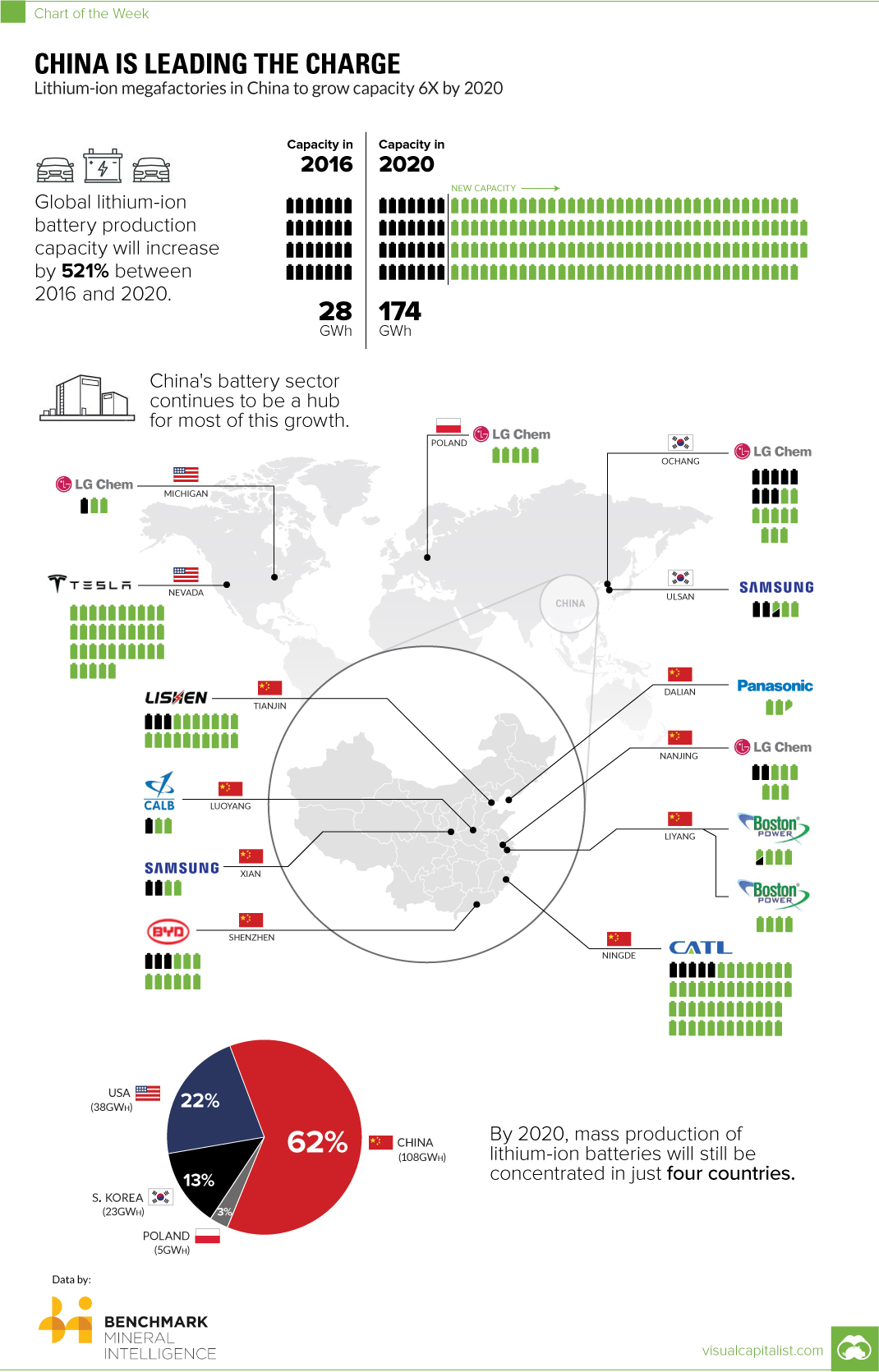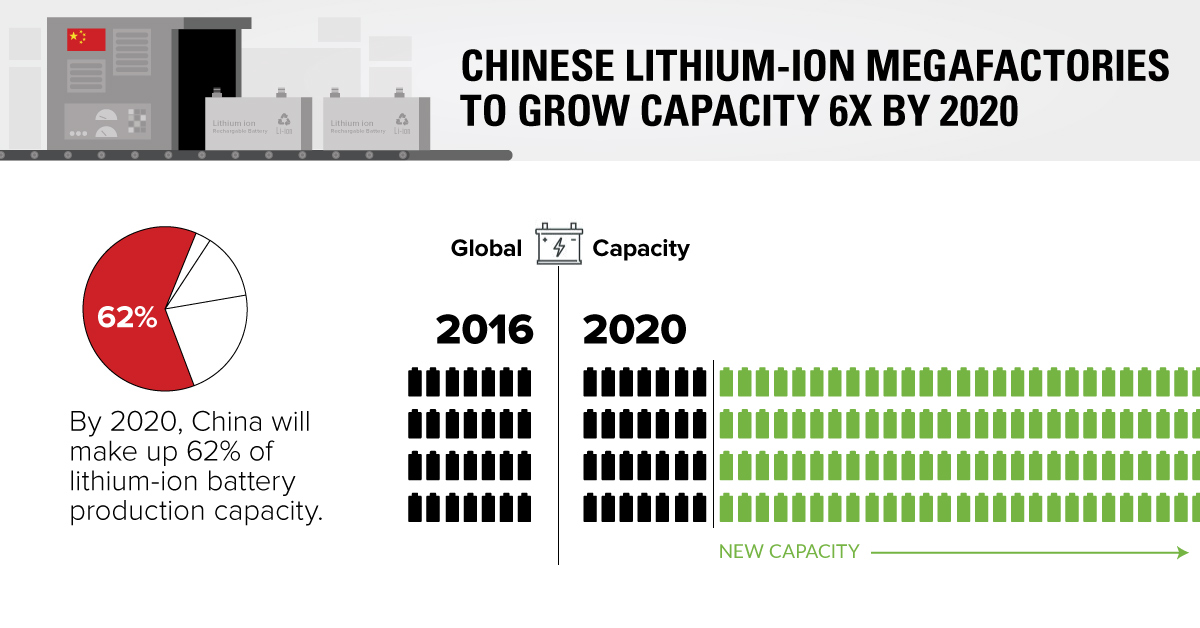Technology
China Leading the Charge for Lithium-Ion Megafactories

China Leading the Charge for Lithium-Ion Megafactories
The Chart of the Week is a weekly Visual Capitalist feature on Fridays.
Tesla’s Gigafactory 1 has been a center of attention for people interested in the growing momentum behind green energy, electric cars, and battery production. Therefore, it is no surprise that this facility was in the news again last month, with Tesla starting to mass produce batteries as it ramps up to its goal of 35GWh of capacity and beyond.
However, as exciting as this project is, it’s actually just one of multiple large-scale “megafactories” being built – with many of them being in China.
China Leading the Charge
We talked to Simon Moores, Managing Director at Benchmark Mineral Intelligence, who explained that Tesla isn’t alone or unique in its ambitions to build lithium-ion batteries at scale:
While the Tesla Gigafactory is vitally important from an EV vertical integration perspective, the majority of new lithium-ion battery capacity is being built in China. Some of these plants are expected to be huge such as the CATL facility at 50GWh – there is little doubt that China’s lithium-ion industry has come of age.
Contemporary Amperex Technology Ltd (CATL) has plans to build the largest lithium-ion megafactory of all – but the company is little known in North America. It’s already worth $11.5 billion, and could be a dominant force globally in the battery sector if it successfully increases its lithium-ion production capacity six-fold to 50GWh by the year 2020.
Other Chinese manufacturers are on a similar trajectory. Panasonic, LG Chem, and Boston Power are building new megafactory plants in China, while companies such as Samsung and BYD are expanding existing ones. All lithium-ion plants in China currently have a capacity of 16.4GWh – but by 2020, they will combine for a total of 107.5GWh.
Capacity by Country
This ramp up in China means that the country will have 62% of the world’s lithium-ion battery production capacity by 2020.
There are only three other players in the megafactory game: United States, South Korea, and Poland.
| 2016 Capacity (GWh) | 2020 Capacity (GWh) | % of Global Total (2020) | |
|---|---|---|---|
| United States | 1.0 | 38.0 | 22% |
| China | 16.4 | 107.5 | 62% |
| Korea | 10.5 | 23.0 | 13% |
| Poland | 0.0 | 5.0 | 3% |
| Total | 27.9 | 173.5 | 100% |
Above estimates on battery capacity courtesy of Benchmark Mineral Intelligence.
Technology
All of the Grants Given by the U.S. CHIPS Act
Intel, TSMC, and more have received billions in subsidies from the U.S. CHIPS Act in 2024.

All of the Grants Given by the U.S. CHIPS Act
This was originally posted on our Voronoi app. Download the app for free on iOS or Android and discover incredible data-driven charts from a variety of trusted sources.
This visualization shows which companies are receiving grants from the U.S. CHIPS Act, as of April 25, 2024. The CHIPS Act is a federal statute signed into law by President Joe Biden that authorizes $280 billion in new funding to boost domestic research and manufacturing of semiconductors.
The grant amounts visualized in this graphic are intended to accelerate the production of semiconductor fabrication plants (fabs) across the United States.
Data and Company Highlights
The figures we used to create this graphic were collected from a variety of public news sources. The Semiconductor Industry Association (SIA) also maintains a tracker for CHIPS Act recipients, though at the time of writing it does not have the latest details for Micron.
| Company | Federal Grant Amount | Anticipated Investment From Company |
|---|---|---|
| 🇺🇸 Intel | $8,500,000,000 | $100,000,000,000 |
| 🇹🇼 TSMC | $6,600,000,000 | $65,000,000,000 |
| 🇰🇷 Samsung | $6,400,000,000 | $45,000,000,000 |
| 🇺🇸 Micron | $6,100,000,000 | $50,000,000,000 |
| 🇺🇸 GlobalFoundries | $1,500,000,000 | $12,000,000,000 |
| 🇺🇸 Microchip | $162,000,000 | N/A |
| 🇬🇧 BAE Systems | $35,000,000 | N/A |
BAE Systems was not included in the graphic due to size limitations
Intel’s Massive Plans
Intel is receiving the largest share of the pie, with $8.5 billion in grants (plus an additional $11 billion in government loans). This grant accounts for 22% of the CHIPS Act’s total subsidies for chip production.
From Intel’s side, the company is expected to invest $100 billion to construct new fabs in Arizona and Ohio, while modernizing and/or expanding existing fabs in Oregon and New Mexico. Intel could also claim another $25 billion in credits through the U.S. Treasury Department’s Investment Tax Credit.
TSMC Expands its U.S. Presence
TSMC, the world’s largest semiconductor foundry company, is receiving a hefty $6.6 billion to construct a new chip plant with three fabs in Arizona. The Taiwanese chipmaker is expected to invest $65 billion into the project.
The plant’s first fab will be up and running in the first half of 2025, leveraging 4 nm (nanometer) technology. According to TrendForce, the other fabs will produce chips on more advanced 3 nm and 2 nm processes.
The Latest Grant Goes to Micron
Micron, the only U.S.-based manufacturer of memory chips, is set to receive $6.1 billion in grants to support its plans of investing $50 billion through 2030. This investment will be used to construct new fabs in Idaho and New York.
-

 Debt1 week ago
Debt1 week agoHow Debt-to-GDP Ratios Have Changed Since 2000
-

 Markets2 weeks ago
Markets2 weeks agoRanked: The World’s Top Flight Routes, by Revenue
-

 Countries2 weeks ago
Countries2 weeks agoPopulation Projections: The World’s 6 Largest Countries in 2075
-

 Markets2 weeks ago
Markets2 weeks agoThe Top 10 States by Real GDP Growth in 2023
-

 Demographics2 weeks ago
Demographics2 weeks agoThe Smallest Gender Wage Gaps in OECD Countries
-

 United States2 weeks ago
United States2 weeks agoWhere U.S. Inflation Hit the Hardest in March 2024
-

 Green2 weeks ago
Green2 weeks agoTop Countries By Forest Growth Since 2001
-

 United States2 weeks ago
United States2 weeks agoRanked: The Largest U.S. Corporations by Number of Employees













